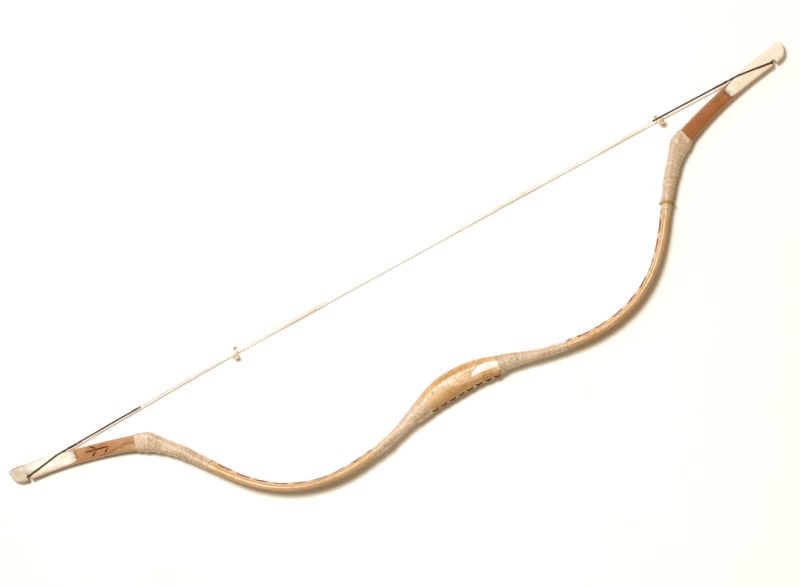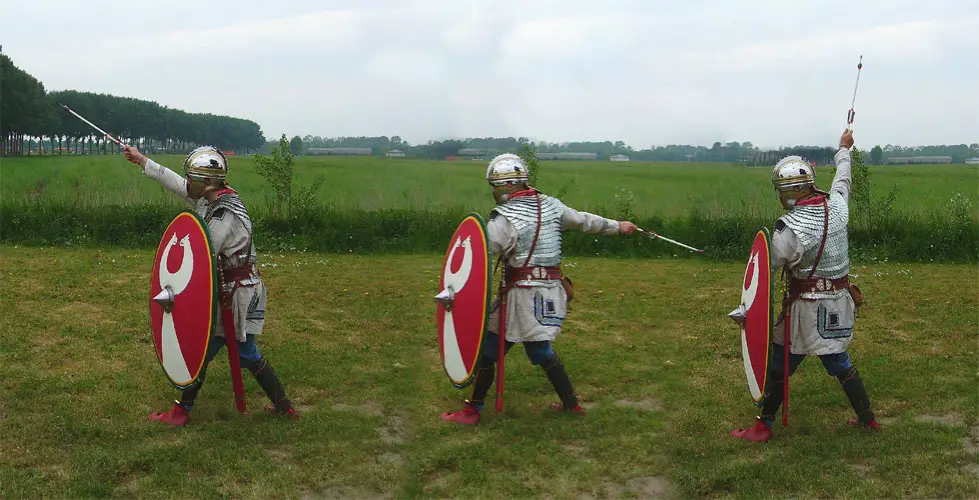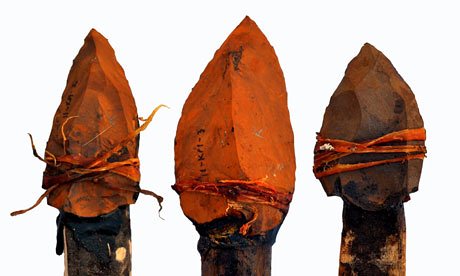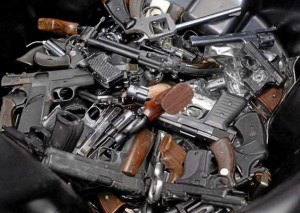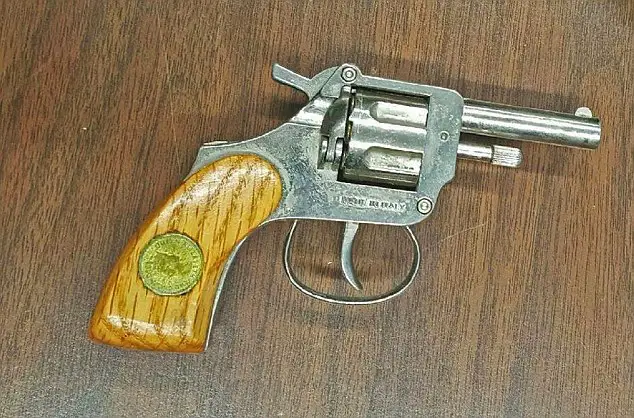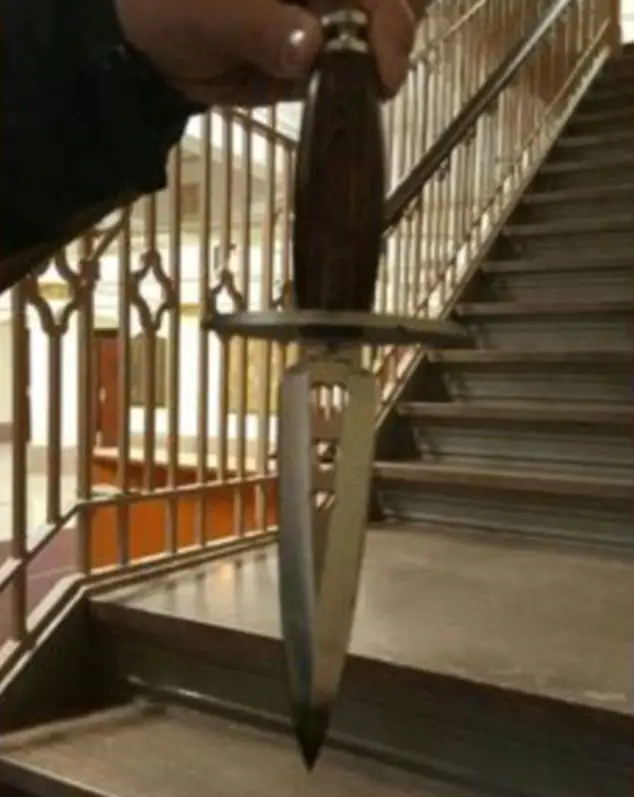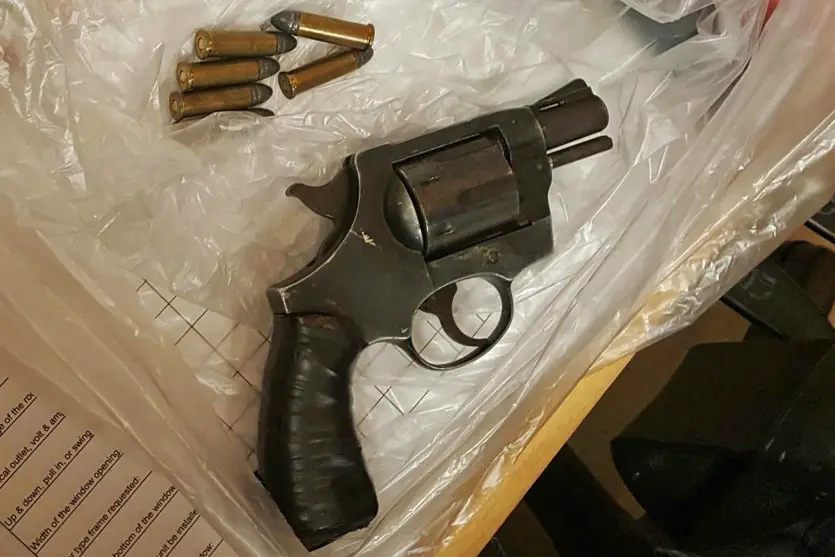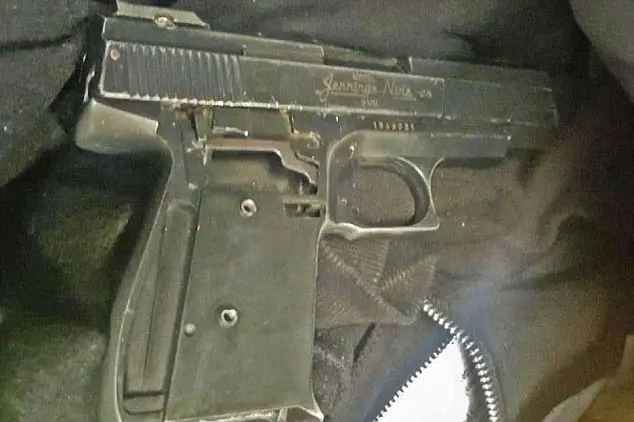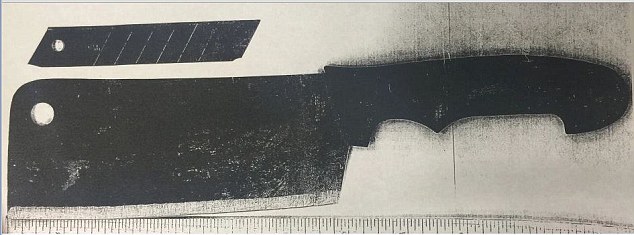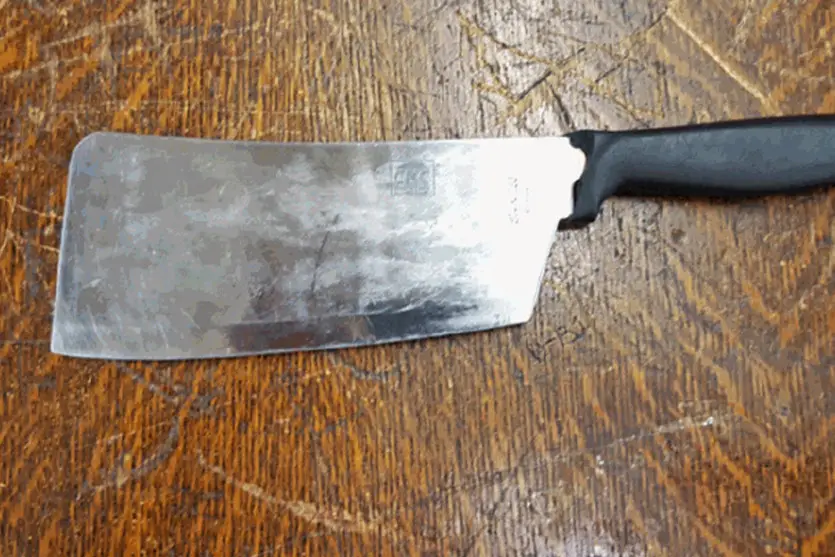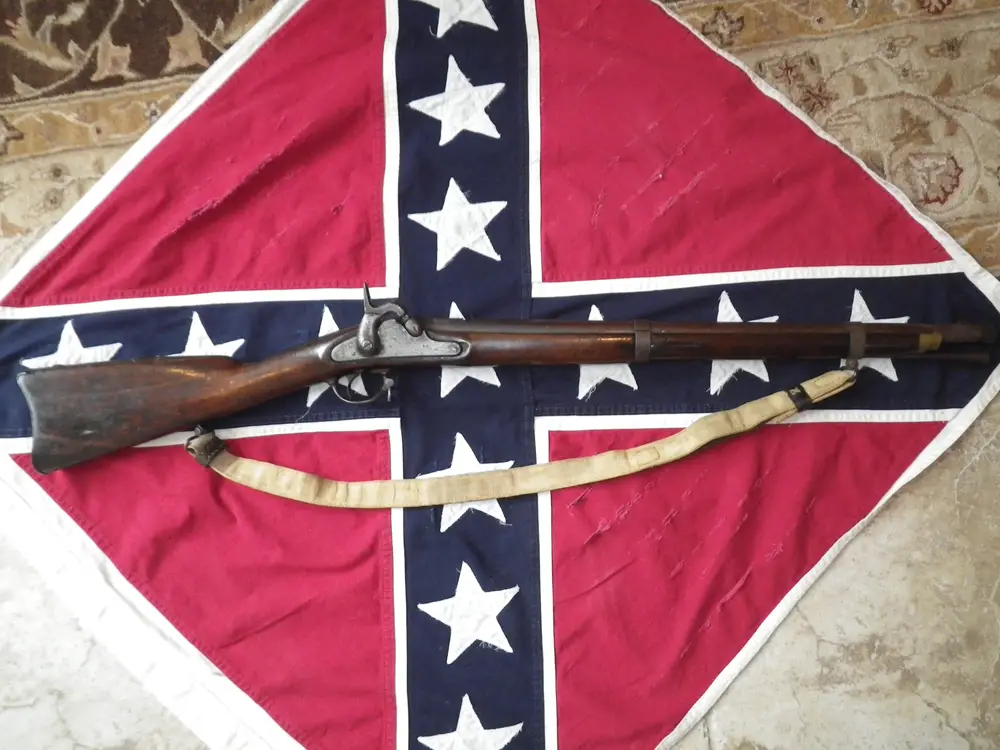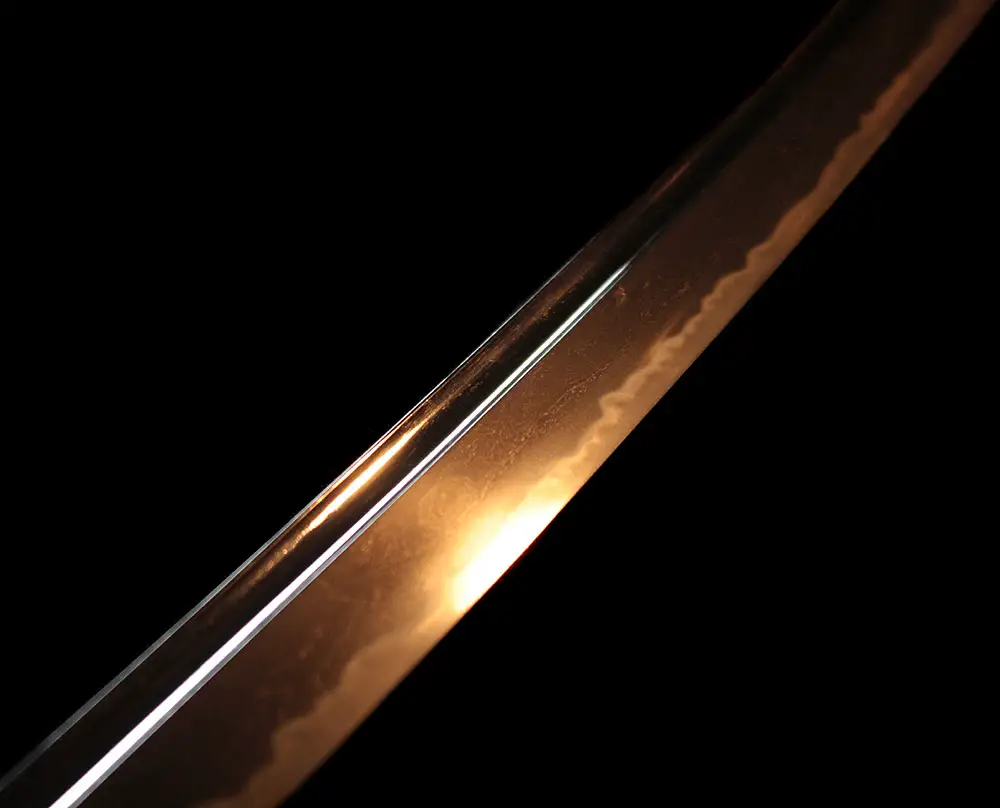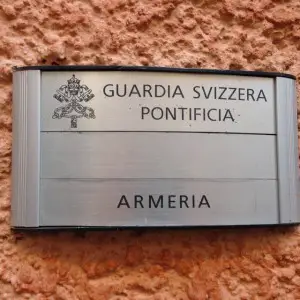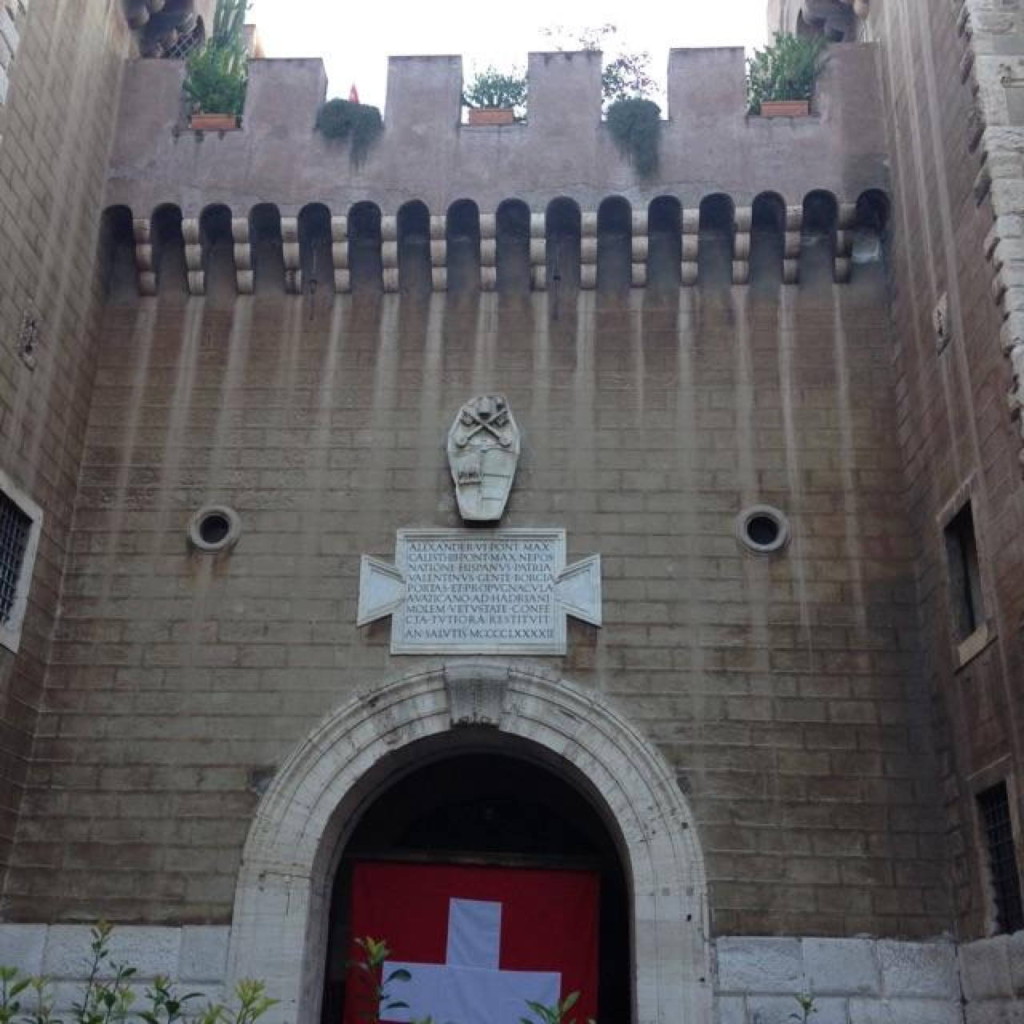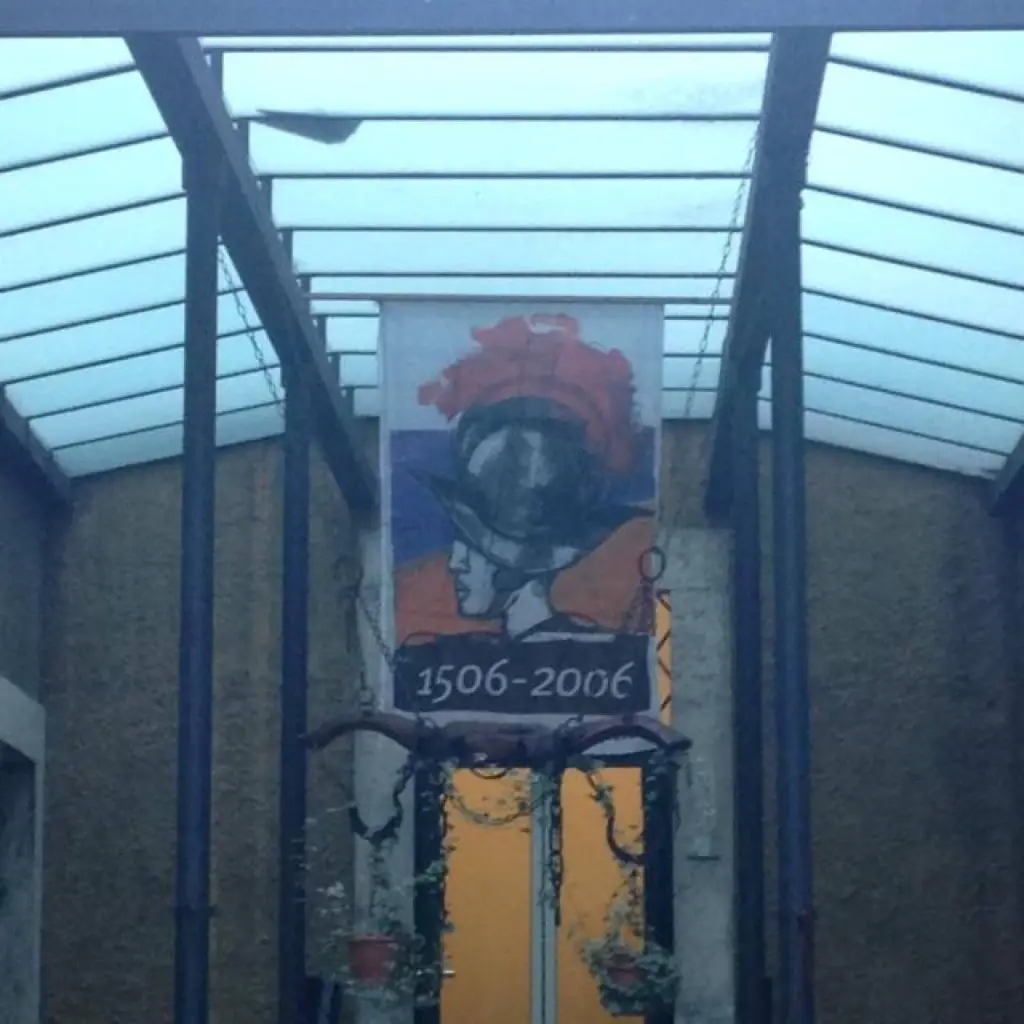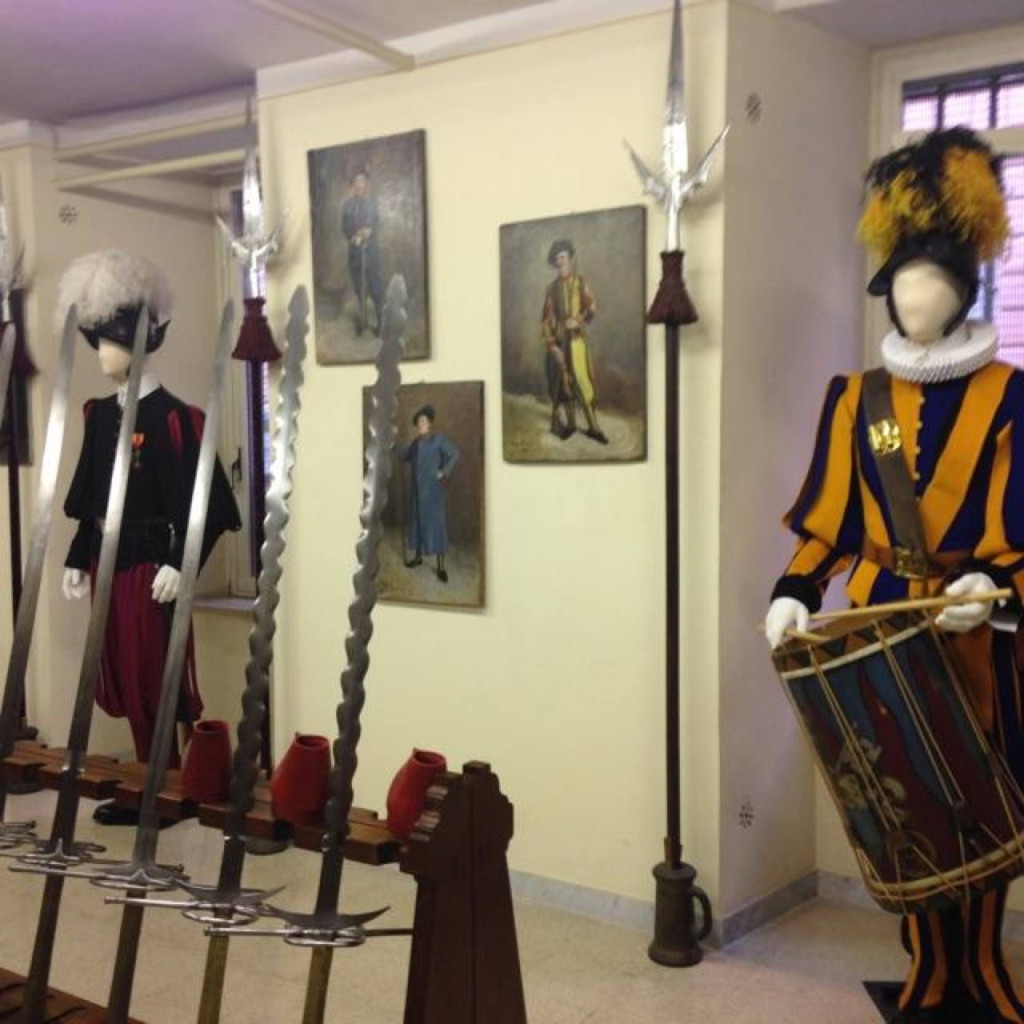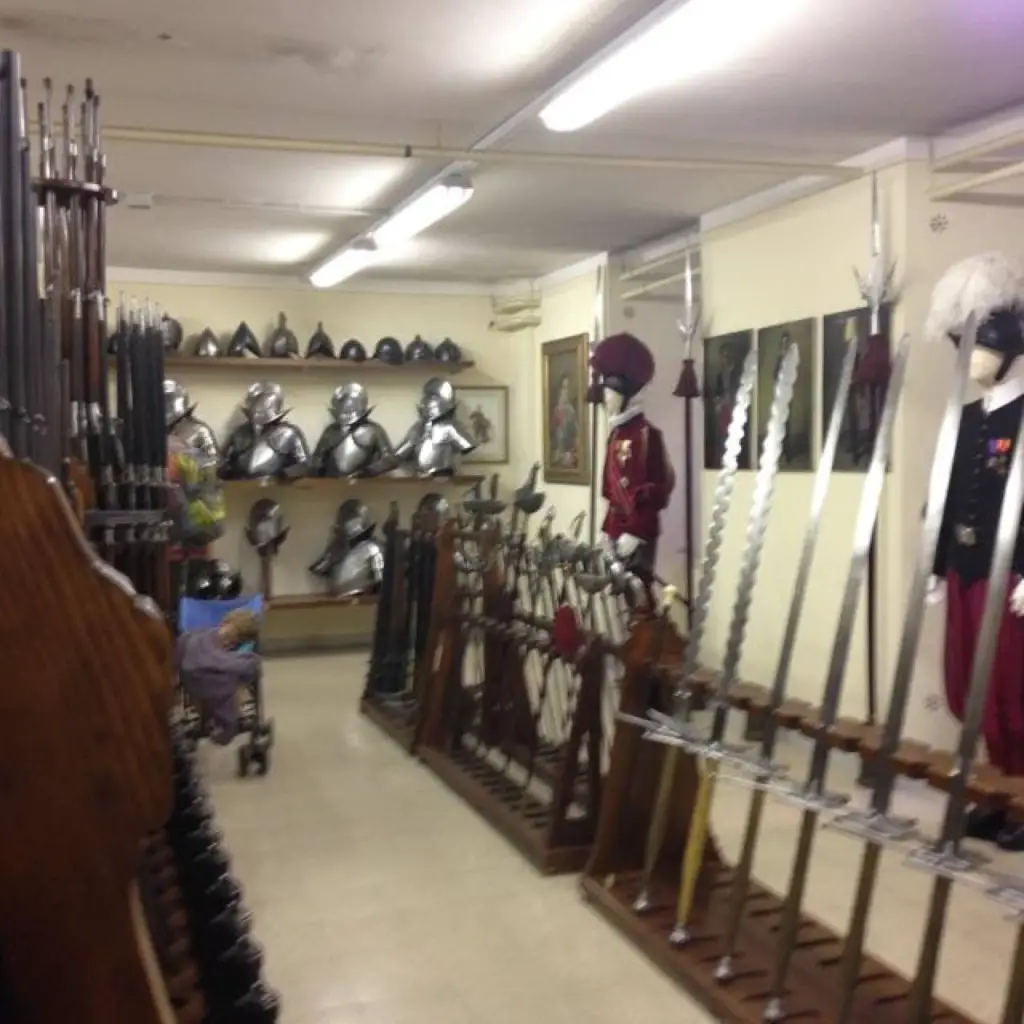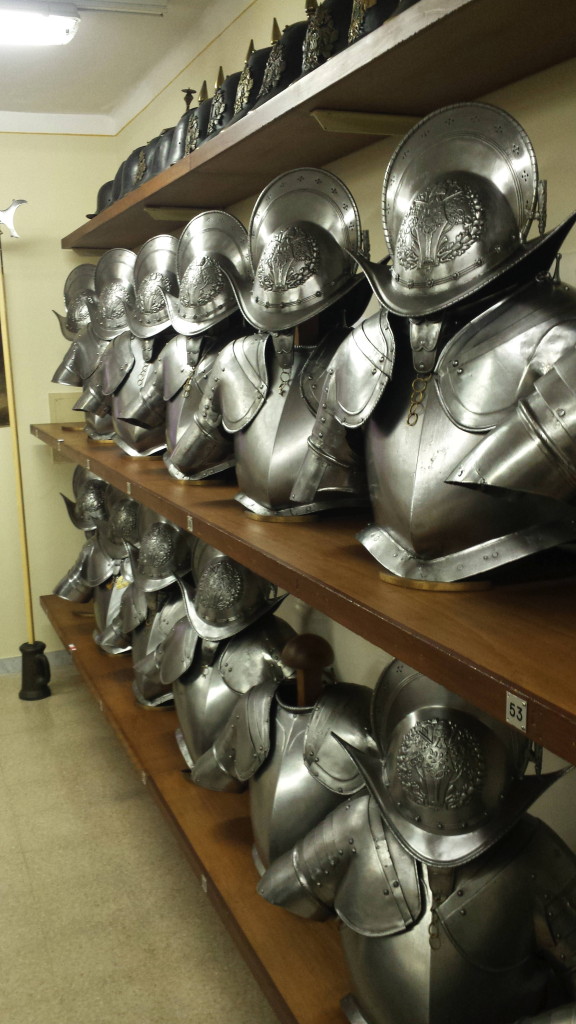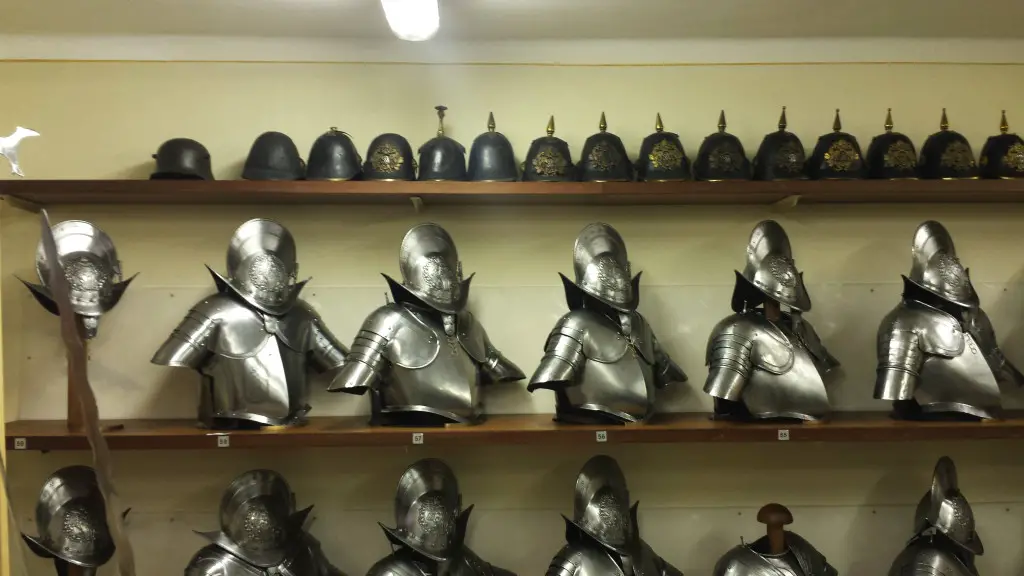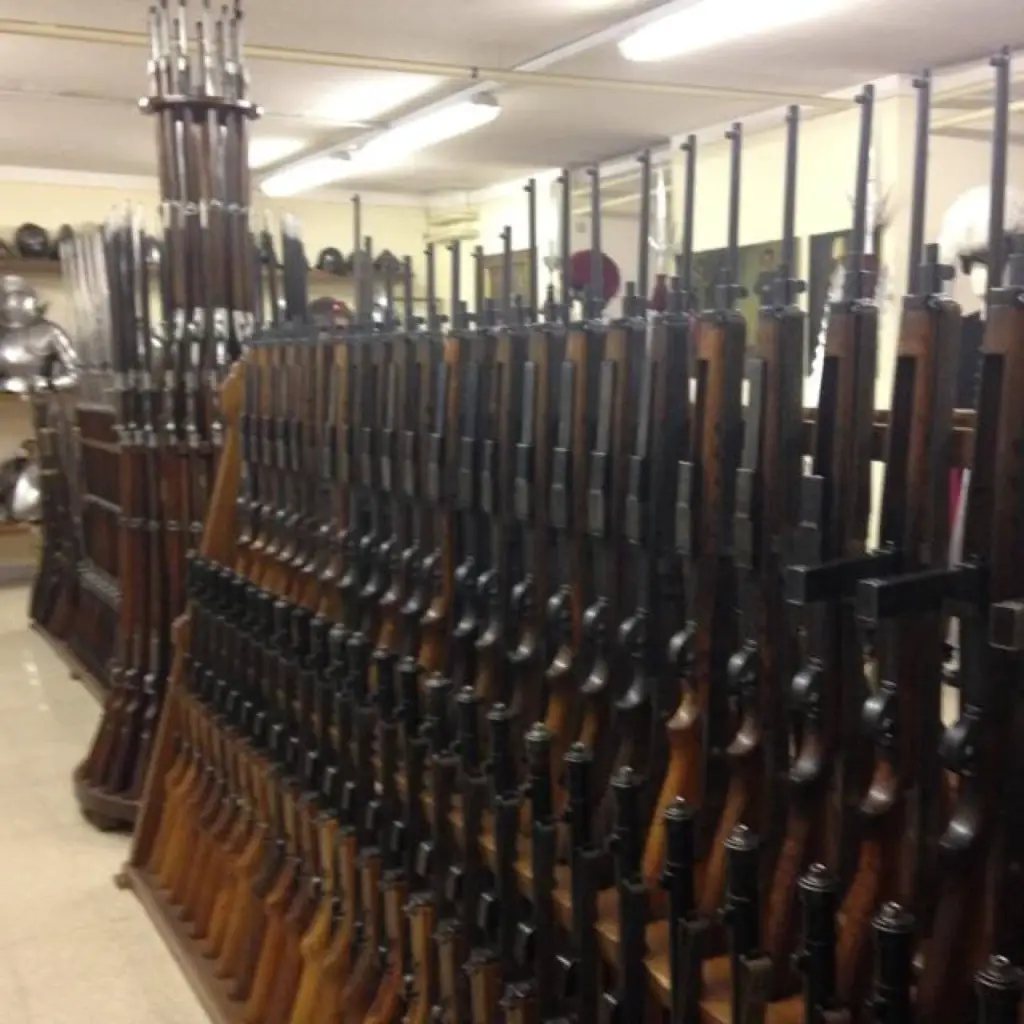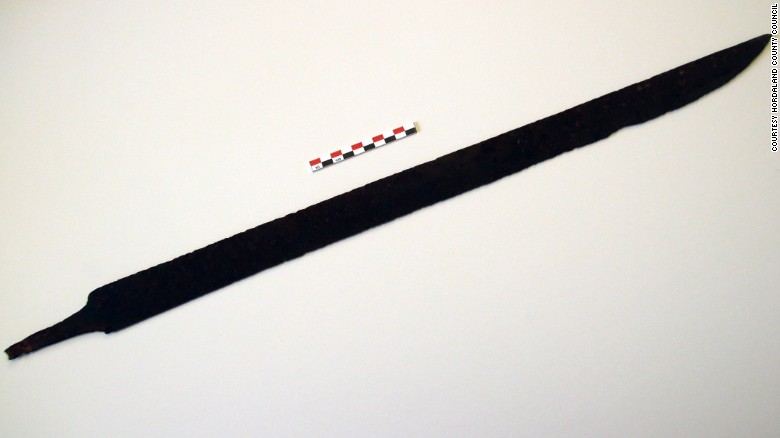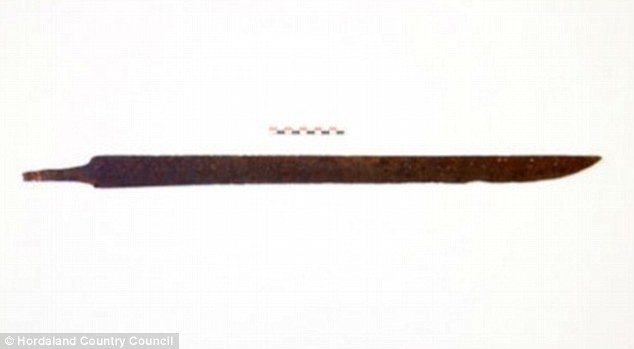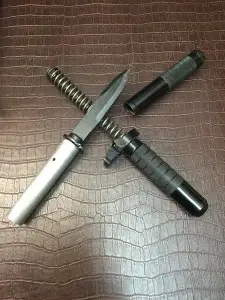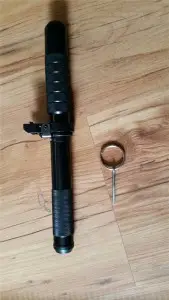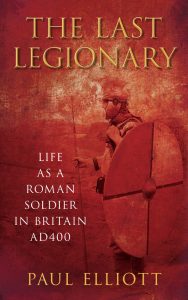 All modern armies owe something to the Legions of Ancient Rome. A fascinating book, The Last Legionary by Paul Elliott, describes, as its subtitle suggests, Life as a Roman Soldier in Britain, AD 400.
All modern armies owe something to the Legions of Ancient Rome. A fascinating book, The Last Legionary by Paul Elliott, describes, as its subtitle suggests, Life as a Roman Soldier in Britain, AD 400.
The book combines, in the style of Christopher Matthew’s A Storm of Spears (on the Greek hoplite at war; only $1.26 at that link; previously mentioned here in comments and here), the disciplines of history, material archaeology, and “experiential archaeology” as practiced by reenactors. Where The Last Legionary is different is that its facts about the Roman military’s last years in Roman Britannia are woven into the story of an simple soldier, we guess you could say an ordinary Gaius. Gaius was born in 362 to a Roman legionary, Maritius, and his wife, and on reaching his majority was compelled to join up under the edict of Diocletian, which committed sons to their fathers’ professions. Some youths dodged the draft by cutting their thumbs off, which was discouraged initially by burning the draft dodgers and later by drafting them anyway.
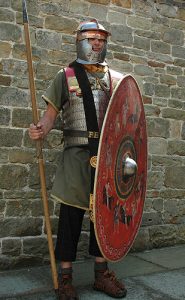 Gaius was no draft dodger, and accepted his fate. He swore an oath (to Christ and the Emperor) to serve, and if need be, die for the Roman Empire. Training was harsh and hardening, including formation drill, fast marches, position and fortification construction, and plenty of physical training.
Gaius was no draft dodger, and accepted his fate. He swore an oath (to Christ and the Emperor) to serve, and if need be, die for the Roman Empire. Training was harsh and hardening, including formation drill, fast marches, position and fortification construction, and plenty of physical training.
Of most interest to our readers is probably the weaponry on which Gaius was expected to gain proficiency. While the Roman Legion of Caesar’s day fought primarily close-in with spear and short sword, by the fourth century projectiles were a major part of combat. To be a properly cross-trained legionary, Gaius would have to learn to master the sling, the recurve bow, the plumbata dart, three kinds of javelin, the crossbow ,and the barbarians’ own throwing axe, as well as the classical sword, shield and spear of centuries before. Indeed, missile weapons training usually began before close-in weapons training.
Late Roman Missile Weapons
The sling was a leather or woven cup with a cord proceeding from two corners. One cord is looped around the index finger, that’s the standing end of the sling; the other is tied in a knot, which is the running end, and the slinger releases it to launch the projectile — a stone, or a lead ball — but accuracy is hard to achieve, the author has learned. Roman sources suggest a single whip round, and setting the practice targets at — wait for it — 180 meters, same as for bows. Elliott has been unable to achieve this range, with the regular sling or using one with the cords proceeding form a stick.
The recurve bow came to the Roman army from encounters with Eastern enemies so armed. Mostly these were the tribes of the East; for centuries the Romans had trouble with Scythians and Parthians, among others.
The Romans adopted the recurve bow after seeing its effect first hand, and while it only bought them parity in the East, in the West it gave them technological superiority to the “self-bow” of the Gauls and Germans.
Often the ends or “ears” of the bow was strengthened with bone laths, and the body of the bow was carefully covered with leather to protect it from moisture. Wet conditions could ruin a recurve bow, as could misuse. Leaving the bow stringed and ready for action ruins the springiness of the bow and reduces its power. Unlike the sling, specialist craftsmen were needed to make these complex weapons.
The bowstring was drawn differently in units raised and trained in the eastern and western units. Western-trained archers shot using the fingers of their strong hand; Eastern-trained archers used a thumb ring. While archers could fire at individual targets, they were often used in volley fire.
The plumbata was a recent (~4th Century) addition to the Roman grunt’s panoply. It was a lead-weighted dart, shorter than an arrow, that could be thrown by hand or launched — as far as 100 m! — with a sling or throwing stick.
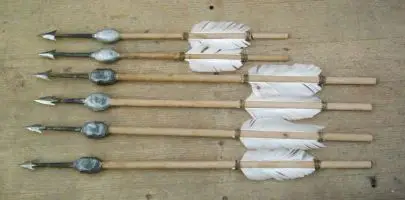
Reconstructed plumbatae. Source.
Testa by the historical research group, Comitatus, have found that an underhand throw was by far the best method.The plumbatae can reach an impressive distance, easily exceeding 60 m, and come down vertically directly onto the heads and shoulders of the enemy.
This is a different re-enactor group throwing plumbatae. From Roman-Artifacts.com.
Another Roman name for the plumbata was the “Barb of Mars.”
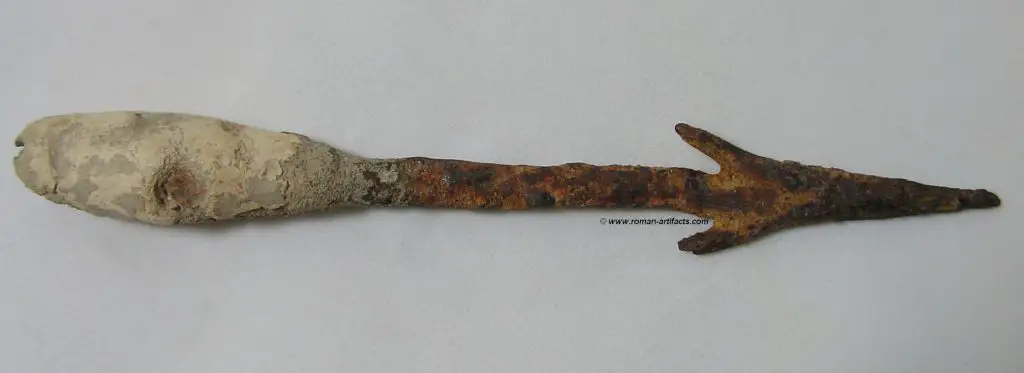
Surviving plumbata head. Source.
Romans used several types of javelins, known by the names pilum, spiculum, and verutum, but while these were nominally throwing weapons, they were hard to throw accurately or any distance.
Two weapons of secondary importance were the throwing axe, adopted from some of the northern Germanic tribes, and the crossbow, which was probably developed by scaling down a siege engine, but was rather new at the time. (Elliott cites sources that make it clear that the late Roman Empire deployed this weapon, which he points out that most people associate with medieval warfare. There was more continuity between antiquity and modernity than “dark ages” historiography suggests).
Late Roman Close Combat Weapons
The two basic combat weapons of antiquity were the sword and the spear. Technology had not stood still, and the soldier who fought blue-painted Britons in Roman Britain wasn’t armed quite like his ancestor in Caesar’s legions had been.
The sword was the spatha, a longer (~700mm) sword than the classic gladius of Caesar’s age. It was originally a weapon for cavalry.

Third Century spatha. Source.
Spatha were not crude mass-produced weapons, they were carefully wrought swords, often with pattern-welded blades. These blades were formed from several iron bars, all of different carbon content, that would twisted into a screw shape and then hammered and folded repeatedly. To this strong, yet flexible, core, hardened steel cutting edges were welded. The blades are strong and beautiful, with long straight sides and sharp points. The hilts and pommels were crafted from wood, horn or bone – all organic materials. In earlier centuries, the legionary sword hung on the soldier’s right side, but in the fourth century, soldiers wore their swords on the left, traditionally the preserve of centurions and senior officers.
In man to man combat the sword was used to stab into the body of a foe, but when engaging a shielded target the long spatha could be used to reach over the Shield to strike the head or neck, the shoulders, the sword arm, or the left leg….
If the spatha was the 400 AD legionary’s offensive weapon, his tactical defensive weapon was the spear. Spears had seen a lot less technological change in the preceding 400 years, but that’s for the best of reasons: they were quite well evolved already. A single spearman on the battlefield would have been vulnerable to being flanked and defeated by more agile foes, but no army — certainly not the Romans! — fights as individuals. Attacking a unit of spear-armed Romans was a mortal-consequences game of Slap The Porcupine. Wise enemies didn’t try, and unwise ones died or wised up PDQ.
The Roman shield, on the other hand, had changed since Caesar’s day. Caesar’s legions carried a rectangular shield, that in overhead plan view had an arc to it. The late Empire infantryman had a round shield, which worked better with the long spatha.
The infantryman of 400 AD had a great many weapons to master, along with all the other soldier skills of the day. And we enjoyed learning about his training, combat, and life in general, in The Last Legionary.
Knife. Camera. Action!
Object of lesson: do not do this with a knife.
This knuckleheaded kid did this to himself a few days ago, and he was due for surgery Friday. Presurgical situation was no sensation in his right pinkie finger beyond the proximal interphalangeal joint (second joint from the tip), and little motor control of the finger. (He had less serious wounds to the proximal section of the ring finger and to the palm).
Apparently a lot of people follow this young man, Lance Stewart, and enjoy their frequent (daily?) slices of his well-heeled if rudderless life. He likes knives, so his fans send him knives (them that has, gets). He’s deuced lucky to still have fingers.
If you replay the video, you can hear the dull thwack of knife meeting flesh and bone. In this, it probably helps that he did this with the mall-shop decorations he did, and not with, say, a pair of quality katanas or even British GI kukris.
His YouTube style is, uh, not for everyone. Hey, it takes all kinds to make a world, and he did put it out there for all of us to see, and perhaps someone will learn from it (even if it’s a lesson most of us who’ve worked professionally with knives would never have needed).
Note that the video appears to have a different splash screen than it had yesterday (then, it was his moment of anguished screaming), so we don’t know if he’s edited the video, but in the version we watched, the knife error comes up within the first 15-20 seconds, but do keep watching for the fainting at 0:55 or so, not to mention the wailing, the gnashing of teeth, and the lamentations of the women.
At one point, someone chastises his friend for keeping filming through the whole thing, and the friend points out that Lance wanted him to. We’re one day closer to the world depicted in Idiocracy, and it seems that the TV show featured there could be a reality any day. At least on YouTube.
Despite his failure to engage forebrain before dual-wielding mall-ninja machetes, Lance seems like a personable kid, and we wish him a complete recovery from his injury.
Infantry Weapons, 498,000 BC: Stone-tipped Spears
OK, this article from The Grauniad is a good three years old. But we seem to have missed it then, so there’s a good chance you missed it then, too. Let’s not miss it now! Here’s why stone-tipped spears were important: the first known spears date from 600,000 years ago, but they were just sharpened sticks. They could have been made by several arguably pre-human, protohuman or early human species, before the emergence of modern Homo sapiens or even our most recent extinct cousin, Homo neanderthalensis. Until recently, all evidence for stone-tipped spears came from the last 300,000 years and were arguably attributable to H. sapiens or to Neanderthals.
A research dig in South Africa led then-Toronto (now Arizona State) archaeologist Jayne Wilkins to a surprising conclusion: our ancestors were making stone-tipped spears before they were even exactly “human.” First, the importance of the technology:
The invention of stone-tipped spears was a significant point in human evolution, allowing our ancestors to kill animals more efficiently and have more regular access to meat, which they would have needed to feed ever-growing brains. “It’s a more effective strategy which would have allowed early humans to have more regular access to meat and high-quality foods, which is related to increases in brain size, which we do see in the archaeological record of this time,” said Jayne Wilkins, an archaeologist at the University of Toronto who took part in the latest research.
The technique needed to make stone-tipped spears, called hafting, would also have required humans to think and plan ahead: hafting is a multi-step manufacturing process that requires many different materials and skill to put them together in the right way. “It’s telling us they’re able to collect the appropriate raw materials, they’re able to manufacture the right type of stone weapons, they’re able to collect wooden shafts, they’re able to haft the stone tools to the wooden shaft as a composite technology,” said Michael Petraglia, a professor of human evolution and prehistory at the University of Oxford who was not involved in the research. “This is telling us that we’re dealing with an ancestor who is very bright.”
It may not take a genius to make spears, but it probably took a genius to invent one.
Dating the stone tips to 500,000 years ago means that they were used on spears by the last common ancestor of modern humans and Neanderthals, Homo heidelbergensis. The idea that Homo heidelbergensis developed stone-tipped tools made a lot of sense, said Petraglia, because Homo sapiens and Neanderthals, which descended and split from Homo heidelbergensis around 300,000-400,000 years ago, used similar stone-tipped spear weapons.
Petraglia added that there were several other implications to the discovery thatHomo heidelbergensis had used hafting to make spears. Adding stones would not only have given our ancestors an easier way to kill prey, but also to do it from a distance. “There is a big difference between thrusting and throwing,” he said. “You can kill from a distance, maybe 10 to 30 metres away. The previous ancestors did not have that technology, so it means you are now occupying a new ecological niche, you can now take animals down more efficiently.”
Meanwhile, while the archaeologists seem to think only of the spears as hunting weapons, not as warfare tools, they theorize that hunting meat with these spears was not just an effect of rising intelligence, but a cause as well:
He added that the discovery also shed light on the development of modern human cognition. “Hominins – both Homo erectus and earlier humans – were into this meat-eating niche and meat-eating is something that is thought to be very important in terms of fuelling a bigger brain,” said Petraglia. “In terms of our evolutionary history, that’s been going on for millions of years. You have selection for a bigger brain and that’s an expensive tissue and that protein from meat is a very important fuel, essentially. If you become a killing machine, using spears, you’ve come up with a technological solution where you can be reliant on meat-eating constantly. Homo heidelbergensis is known as a big-brained hominid, so having reliable access to meat-eating is important.”
It’s a fascinating article, and deep for a newspaper (and the Grauniad of all things!). For more depth, the Science article is available to subscribers and members of the AAAS. The free teaser:
Ancient Weaponry
Hafting, which allowed projectile points to be attached to a staff, was an important technological advance that greatly increased the functionality of weapons of early humans. This technology was used by both Neandertals and early Homo sapiens and is readily seen after about 200,000 to 300,000 years ago, but whether it was used by a common ancestor or was separately acquired by each species is unclear. Supporting use by a common ancestor, Wilkins et al. (p. 942) report that stone points in a site in central South Africa were hafted to form spears around 500,000 years ago. The evidence includes damaged edges consistent with this use and marks at the base that are suggestive of hafting.
Abstract
Hafting stone points to spears was an important advance in weaponry for early humans. Multiple lines of evidence indicate that ~500,000-year-old stone points from the archaeological site of Kathu Pan 1 (KP1), South Africa, functioned as spear tips. KP1 points exhibit fracture types diagnostic of impact. Modification near the base of some points is consistent with hafting. Experimental and metric data indicate that the points could function well as spear tips. Shape analysis demonstrates that the smaller retouched points are as symmetrical as larger retouched points, which fits expectations for spear tips. The distribution of edge damage is similar to that in an experimental sample of spear tips and is inconsistent with expectations for cutting or scraping tools. Thus, early humans were manufacturing hafted multicomponent tools ~200,000 years earlier than previously thought.
Nietzsche said, “That what does not kill you, makes you stronger.” WeaponsMan.com says, “That with which you kill, makes you smarter.” If our H. erectus and heidelbergensis forbears had been vegans, we might still be apes.
Technically-minded readers will enjoy a follow-on paper from 2014 (from PLOS ONE, freely available) which explores the relative performance of hafted-stone and solid-wood spears “thrown” by a calibrated crossbow into ballistic gelatin. (This article has several fascinating aspects and deserves exploration in depth).
Since its publication, Wilkins’s original article has been criticized as, in the words of one critical article, an “abuse of the use-wear method.” Wilkins and three co-authors defended their findings in a further follow-on paper last year, and accused their critics of “using our paper as a straw-man example of the abuse of use-wear.” As archaeology disputes go, it’s a bit heated, but they haven’t resorted to spears. Yet.
A School System Full of Weapons
“A School System Full of Weapons”? Actually, that describes what we had growing up, where one of the teachers might bring in his Springfield and some old gear to illustrate something about the First World War, or a couple of us might have squirrel guns in our cars for after school. All the guys carried a pocket knife and a lighter.
Today, they’d probably throw us so far back in the school brig that we’d have to be fed by Wrist Rocket. And actually fire the teachers (but keep the pervy ones, because Vibrant Diversity® FTW). Then, they didn’t have a school brig. See what Progress® gets ya?
So that leaves us a little unsure how to react to this tale in the Daily Mail. It’s hard to get inside the minds of the uncredited reporter there; we suppose it’s a steady job, but he wants to be a paperback writer. Anyway, we’re not sure whether the best angle on this is:
- the sheer gun-fearing wussiedom of the schools;
- the degree to which Britons are aghast that Yanks have eeeeewwww guns. (We can assure our UK readers that they are not slimy, merely smooth and cool to the touch);
- the fact that all this keys off a notoriously mobbed-up union, the Teamsters, getting twaumatized by weapons in the schools (we’ll believe the Teamsters have turned over a new leaf when they give up the mortal remains of purged capo Jimmy Hoffa);
- the fact that the famously-violent union supposedly twaumatized by all these guns supported Andrew Cuomo and his SSAFE Act, which was supposed to usher in the era of the New Soviet Man or something;
- The laziness of reporters, which we bring full circle by writing a report based entirely on a Daily Mail report which is based entirely on a New York Post report which is based entirely on sniveling provided by the union goon. At least we’re self-aware; not sure if the paperback writers in Fleet Street are, also. If so, Troll Level: Journeyman at least.
Anyway, here’s the Mail, with some interspersed snark:
Terrifying haul of 2,000 revolvers, handguns, meat cleavers and daggers confiscated from children as young as 11 in NY schools in just 10 months… and the NYPD are trying to keep the problem a secret.
Um, revolvers are handguns. Would you write “Horses, animals, vegetables and minerals…”? Well, you actually mightn’t, but they very well might. It is the Daily Mail, after all.
1,751 guns, knives and other weapons were confiscated from children in the city’s schools between July 1, 2015, and May 8 of this year.
Didn’t he just say 2,000? He did (look in the previous quote). Don’t know how to break it to the Math Is Hard Barbie reporter here, but 1751 ≠ 2000.
That is a rise of more than quarter from the same time last year
Forgive us if we find your estimate a bit dubious, without the underlying number. But it might be right, as the Ferguson Effect has many major-metro cops “going fetal,” to borrow Rahm Emanuel’s evocative condemnation of his own PD; a lot of places have crime up a quarter, and it’s a toss-up whether Rahm or De Blasio despises his cops more.
Shocking figures were released as school safety agents were thanked
The passive voice here hides the fact that the “school safety agent” is a neither-fish-nor-fowl level of city employee who isn’t a teacher, isn’t a cop, but is very well paid for a guy or gal whose occupational requirement is ability to fog mirror. (Like TSA, but the upper crust thereof).
Revolvers, 9mm handguns, meat cleavers and daggers.
These are just some of the weapons schoolchildren are bringing into classrooms in New York City on a daily basis.
Boys and girls, some as young as 11, have taken them out to use during fights while others have used them to target other youngsters.
According to the New York Post, the dangerous items have been confiscated by faculty at schools, some of which don’t have metal detectors.
OK, now they’re admitting that the whole thing is really the Post’s report. Halfway down the page. (Not that the Post, either, is likely to employ someone who can identify a gun three times out of five at five paces).
An investigation has revealed how a huge number of dangerous weapons are being taken into New York schools on a daily basis. This revolver was found on a student at M169 on the Upper East Side.
“An investigation has revealed.” Hell of a way to say, “Union representatives, who are looking for a lever in contract negotiations, handed us a prefab story…” The junk revolver appears to be a die-cast zinc el cheapo, and the Made in Italy origin statement was enough for us to track it down. It’s a close cousin of this cheap Italian .22 blank starter pistol, the Mondial Model 1060, if it isn’t exactly the same thing. The one at the link sold at auction … for a penny. If the Mondial name was ever applied to a real firearm, news of such has yet to arrive in Googlestan.
I bet they don’t submit these to trace, for fear they’d raise Time to Crime numbers and undermine the push for New Laws To Punish Those Who Didn’t Commit Any of These Crimes.
This .38 caliber pistol was found loaded with a single bullet at PS 40 high school in Queens. Safety officials say they are being threatened with punishment if they release information about weapons being taken from kids.
Ah, yes, the mighty Hi-Point. Not only that, it had… drumroll please… “a single bullet.” (The guy would mean cartridge, if he knew what that was. Or maybe he does and has too little faith in the Mail readership. Of course, it can’t be an edgy report without an edged weapon, too:
This dagger was confiscated at Newtown High School in Queens. It was one of 1,751 weapons seized from schoolchildren between July 1, 2015, and May 8 of this year.
Ah, yes. The Mall Ninja Store blue-light special, this. Actually the deadliest weapon of the three, but like the Hi-Point with “one bullet,” it’s probably only good for one shot. “Hey, let’s put some weakening holes in here!” — said no knifesmith, ever.
Hard to imagine the blood of Churchill and Nelson and Shackleton running cold over this pathetic display, but evidently it does. One hopes Alfred the Great is not looking down at the moment, or he might be moved to weep.
But we finally do get to some numbers:
Between July 1, 2015, and May 8 of this year, safety agents and cops recovered a total of 1,751 guns, knives and other weapons in schools.
That’s a rise in 26 percent from the same period last school year, when 1,394 weapons were confiscated, according to data provided to the Post by the NYPD
Gregory Floyd, president of the safety agents union in the city, Teamsters Local 237, told the newspaper the NYPD are cracking down on people who tell the public about the weapons seized from youngsters.
Those who leak information to the press have also been threatened with docked vacation days.
Floyd told the Post: ‘The purpose is to intimidate and to make an example of them so other safety agents will be afraid to report crime.’
He added: ‘If there’s no information to report, (Mayor) de Blasio can come out with his skewed numbers that crime is down and schools are safe, and parents don’t get a true picture of what’s going on.
Now this makes sense in a twisted sort of a way.
‘We shouldn’t be in the secrecy business. We should be in the business of making sure weapons brought to school doesn’t happen.’
Well, with that command of grammar, he’d better stick with his union gig. Of course, we can’t expect too much from the guy, he’s probably a graduate of these same pathetic schools.
Mona Davids, president of the New York City Parents Union told the Post: ‘It’s a cover-up, while putting the lives of our children and school staffs at risk.’
Families for Excellent Schools, an organization who has sued the NYPD for failing to protect their children at schools, says the latest statistics proves more weapons are being taken into schools on a daily basis.
Um, the police have no duty to protect anyone in particular. Established law, we’re afraid. And notice the reporter’s lapse into NYC Public School graduate grammar: “statistics proves.” Subject verb agrees should, no?
The NYPD defending its response to the seizures in a statement and insisting information that is ‘disseminated’ must be approved.
Then, the article shoots itself in the foot by announcing the following are “examples of dangerous weapons taken into New York schools in the last two months”. If you read them, you can see they’re more like “examples of dangerous weapons taken into New York schools in the last two months,” but this reporter’s innumeracy apparently extends to the differences between the various single-digit whole integers.
On March 15 – An 11-year-old boy sneaked a .38-caliber handgun loaded with one bullet into PS 40 in Jamaica, Queens. He was seen waving the gun at another student he had a beef with.
That’s the Hi-Point illustrated above. Note: the punk in question was eleven. Given New York’s attitude to crime and criminals, and the expected pace of medical advances, he could still be crimin’ in the 22nd century.
On March 17 – A 15-year-old student stashed a .38-caliber handgun in his backpack and smuggled it into York Early College Academy, a middle school in Jamaica. He was spotted flashing the revolver during a dispute with students in a stairwell.
This kid was Old School, with some cheesy alloy (Zamak strikes again?) .38 Smith knockoff, complete with round-noses and a shades-of-Joe-Colombo electrical taped grip (per criminal legend, defeats fingerprints). The Mail didn’t have the picture but the NY Post did:
Seriously, that’s like a crime gun from 1966 that’s been in some kind of criminal time capsule for the last fifty years.
On March 22 – A 14-year-old boy at Dr. Gladstone H. Atwell Middle School in Crown Heights, Brooklyn took a 9mm pistol and two magazines of bullets in his backpack. When a dean questioned him about a prior fight with neighborhood kids, he admitted packing heat.
That’s this fine example of firearms technology, which appears to have been cared for appropriately:
It’s a “Jennings Nine,” made by the Southern California nest of junk-gun makers that anti-gunners have dubbed “the ring of fire.” Anybody who’s been a cop for a while has taken a Jennings or two into evidence, but the more common ones are the pocket pistols. Thing is, for all their use in crime, many tens of thousands of these kinds of cheap guns are used by people who can’t afford our tuned designer work of defensive art, but still have every right to defend themselves. Drive up the price of guns, and the only gainers are the criminals.
On March 29 – A 14-year-old student at Urban Assembly School for Careers in Sports in Concourse Village in The Bronx pulled a steak knife on a 16-year-old boy.
We’ll go to the Post for this one:
We’re guessing that the “Urban Assembly School for Careers in Sports in Concourse Village in The Bronx” sends more grads (and dropouts) to the NY DOC than to the NBA, NFL or MLB. And we wonder what sport in particular this young sport had in mind.
Now his mom’s one steak knife short. Think she’ll be mad when she finds out?
On April 4 – A 13-year-old boy reportedly threatened a female student with a .22-caliber revolver at M169 Robert F. Kennedy on the Upper East Side, then passed the gun to a friend.
That’s the cheesy zinc alloy revolver visible earlier in this report.
On April 8 – A 16-year-old boy was allegedly found with a medieval-style dagger at Newtown High School in Elmhurst, Queens. It was uncovered after a 17-year-old girl told authorities that he had put it to her neck.
That’s the mall-ninja toad stabber seen above.
And the soi-disant “students” have been expelled from school, charged, and convicted of SAFE Act violations, and sent to prison, right? Right? Anybody?
Don’t be silly. The law is meant to be used as a stick to beat gun-owners Upstate, not Downstate hood rat gangbangers in the school (and hood rat gangbanger wannabees, which is the feedstock of gangbanger production). It’s certainly not meant to be used on actual criminals.
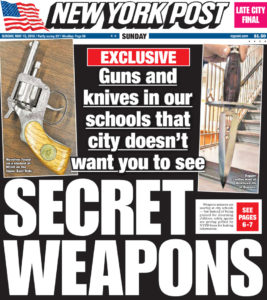 Clicking through to the Post’s story, which was the cover story (right), we see that Postie Susan Edelman, no more au courant on guns than her hoplophobic British opposite numbers, spins it differently:
Clicking through to the Post’s story, which was the cover story (right), we see that Postie Susan Edelman, no more au courant on guns than her hoplophobic British opposite numbers, spins it differently:
These are the guns and knives Mayor de Blasio doesn’t want you to see.
A surging tide of weapons — including loaded revolvers, 9mm handguns, meat cleavers and daggers — has been confiscated this year from students in city schools, most of which do not have metal detectors.
But instead of praising unarmed school safety agents for grabbing the weapons, the NYPD is cracking down on them for alerting the press and public, according to Gregory Floyd, president of the agents union, Teamsters Local 237.
Ah, it’s all Bill De Blowfish’s fault. Have you ever noticed that for New Yorkers, especially New York media functionaries, the worst mayor in history is the one they have right now, compared to the one they had before him, who was second best — and the one they will support to replace this schmo, that next one is going to be the Best Mayor Evah.
Edelman is alarmed that only some schools have metal detectors, and that most of the weapons were seized in schools without. Amazingly, though, almost 700 weapons were seized in the schools with the detectors, making one wonder about those union dudes running. Here’s the number.
Of the weapons seized this academic year, 698 came from schools with metal detectors, the NYPD stats show. Students brought 1,053 weapons — 60 percent of the total — into schools unequipped with metal detectors.
The mayor is reporting crime in the schools is down, but it seems to be simply that juvenile criminals are not being charged.
Floyd also disputes the city Department of Education’s new discipline policy, which discourages student suspensions, and a pilot program to give “warning cards” to students for marijuana possession or “disorderly conduct” such as yelling, cursing, fighting and assaults. Some offenses previously might have warranted a criminal summons.
“In many cases, the children aren’t arrested, so the crime statistics are down, but it’s just not being reported,” Floyd said.
And we’ll close with a couple more of the little darlings’ playthings. The Post says of this catch:
On March 11, a safety agent at Fashion Industries HS in Chelsea found a 4-inch razor blade in a girl’s backpack. When she began to kick and scream, a report said, three agents restrained and handcuffed her before finding a 10½-inch meat cleaver in her bag.
That’s both of them in that grainy picture, the razor blade and the cleaver. And then there’s this cleaver — it’s not the same cleaver, but its point of confiscation is unknown.
Now against that, before you send your kids to the New York City Public Schools, you need to weigh the fact that these Dewey Factories prepare their students (at least the ones that survive to graduation) perfectly well to compete for the unskilled factory jobs of the 1890s and beyond, like at the Triangle Shirtwaist Factory; or to work as slackjawed government clerks.
2050 Years Ago Today: Assassination of Caesar
(Due to the historical anniversary, SF Casualties in SEA This Week has been postponed for a day or two — Ed.).

The Assassination of Caesar is a popular theme in historical art. This painting is credited to CL Doughty.
2050 years ago today, a broad-based Senatorial conspiracy that reached even to Julius Caesar’s friends and allies slew him, fearful of his consolidation of power in a strong executive, which threatened Senatorial and patrician prerogatives.
As is often the case with political revolutions, the consequences of the overthrow and murder of the popular general were broad and long, and did not produce the change the revolutionaries sought (in this case, return to the status quo ante Caesar’s elevation to Pontifex Maximus). Dominic Selwood at The Telegraph has an excellent recounting of the assassination itself, but we’re also interested in the outcomes, which he describes at some length.
Caesar may have brought Rome glory in his conquest of Gaul. He may have started and won a civil war that eventually vested absolute power in him. He may have begun highly popular social and political reforms, and even had time to abolish the chaotic ever-changing calendar and bring in his “Julian calendar,” which lasted a millennium and a half until tweaked by Pope Gregory in 1582. But in his muscular assumption of power, and his popularity among the citizenry, he threatened the deep vested interests of the patricians, who had run the Republic and the Senate for so long. It was enough to seal his fate.
The murder of Caesar did turn out to be a key moment in history.
With Caesar gone, Rome spiralled into another cycle of civil wars, which resulted in one of the most significant constitutional transformations in history. The Eternal City abandoned its trademark republican system of government and became an empire. In place of the Senate electing two consuls each year as joint heads of state, they transferred power to a largely omnipotent emperor. Ever since, people have argued which system was better.
Supporters of the Republic point to how it threw off the tyrannical king Tarquin the Proud and introduced elements of democracy, with power held by the patricians and the plebeians: SPQR, Senatus Populusque Romanus. They note how it found fame and glory in conquering almost all the Mediterranean basin: Italy, Spain, France, Macedonia, Greece, Turkey, Syria, Egypt, Libya, and Tunisia, spreading its influence far beyond ancient Latium.Advocates of the Empire, on the other hand, highlight that the Republic was in reality a hereditary oligarchy in the hands of the wealthy patrician families who ran the all-powerful Senate with no genuine voice for the plebeians, women, or slaves. They also point out that the Republic was too weak to govern effectively at home or abroad, instead relying on “bread and circuses” to keep its citizens happy amid endless civil wars. They note that Rome only truly became a great power under the might of the Empire, which lasted even longer than the Republic, and in the East until A.D. 1453.
via The Ides of March: The assassination of Julius Caesar and how it changed the world – Telegraph.
If there is a moral to this story, it may be as simple as, “Be careful what you ask of the gods, they might give it to you.” The unintended consequences of the slaying of Caesar produced an even greater tyranny in relatively short terms (historically speaking), including such ruinous reigns as Nero’s (within 100 years of Caesar’s murder) and Caligula’s.
In our undergraduate studies in history, we discovered that almost every revolution in the history of the world left the vast majority of people worse off than they had been before, despite the historiography of the revolution always asserting the exact opposite. That’s “worse off” in material terms, but also in terms of freedom. Many of the revolutionaries don’t live to see it, as the revolution often eats its own.
That happened to Brutus (illustrated above on an “Ides of March” coin) and Cassius, who were defeated and died in the two-action Battle of Philippi against Mark Antony’s forces within two years. (Cassius was reported to have died in combat in the first battle; Brutus, by suicide after the defeat in the second, about 2 1/2 weeks later).
Wednesday Weapons Website of the Week: Civil War Arsenal
(Yes, we’re nearly a day behind. Can’t be helped. Right now, just call us … an aspiring wrapper. We’ll be catching up throughout the day, and expect to make only one brief post tomorrow. Saturday we return to the normal schedule. -Ed).
The Civil War is often thought of being boring from a standpoint of small arms development. Nothing could be further from the truth. At the war;s outbreak, many second-line and state militia outfits were armed with smoothbore percussion muzzleloaders, despite the Army’s adoption of a Minie-ball rifle-musket five years earlier. Some of those smoothbore muskets were .69 caliber converted flintlocks. Even at Gettysburg, whole regiments in both armies were firing round balls from smoothbores. By war’s end, the metallic fixed cartridge breechloader had proven its superiority and adaptability, and thanks to this new technology, new repeaters and machine guns were entering service, and something like a recoiling carriage was developed for artillery (it would take decades more for hydraulics to enable a truly practical version, however).
These developments were closely watched by European and Asian officers detailed as observers to the American armies and so they spread worldwide with great rapidity.
In addition, some of the Europeans’ small arms got a combat test, because neither the industry-poor Confederacy nor the industry-rich Union could produce enough modern firearms fast enough to arm new regiments and to reconstitute after losses. (The Austrian Lorenz, an equivalent to the M1855 or M1861 from the ill-fated Harper’s Ferry and surviving Springfield arsenals, was probably the most widely issued of these).
Confederate Dickson-Nelson Rifle.
And the same logistics problem that made the Americans of both nations willing to scour the arsenals, factories and arms bazaars of Europe, meany that every small shop that could perhaps produce muskets, parts or bayonets was rapidly reorganized for that purpose. This was especially true in the South, where both manufacturing capacity and raw materials feedstocks were critically low.
Enter the website Civil War Arsenal, one man’s blog about the CW weapons that he, descended from Revolutionary and Confederate soldiers, collects. There is a heavy emphasis on Confederate weapons, a field of collecting beset by confusion and fakes.
This page is Gene West’s personal contribution to the memory of his ancestors, but it’s also a fine resource for anyone interested in Civil War arms, especially Rebel ones.
If you’re needing a little more Civil War wisdom, here are some more links:
- An expert on the guns of the Harper’s Ferry Arsenal. With the 1859 John Brown raid this was one of the locations involved in the runup to the war; during the war the arsenal was so badly burned and looted by both armies that it was never rebuilt. Today, a National Historic Site.
- Harper’s Ferry’s competitor inside the government, which would survive for over 100 more years, ws the Springfield Armory. Here is the program from its dedication in 1980 as a National Mechanical Engineering Landmark by the American Society of Mechanical Engineers. (Yes kids, that’s what professionally printed stuff looked like before the invention of the Mac and the Laserwriter).
- VMI hosts an interesting correspondence collection on Virginia’s crash program to update militia arms in the period between Brown’s raid and outbreak of open rebellion.
- Milpas.cc has what seems to be accurate and nearly comprehensive information on Civil War muzzleloading rifles (by Armory of production) and breechloading rifles.
Those links are all good stuff. But today, the tile of Wednesday Weapons Website of the Week belongs to Gene West’s Civil War Armory.
Wednesday Weapons Website of the Week: Kanshoan Sword Shop
Kanshoan, a sword shop in Japan, offers up this poem, the origin of which we do not know. Perhaps they made it up:
When you have trouble and you are at a loss,
just look at a sword.
A sword will encourage you.When you’re angry and you have flown into a rage,
just take a deep breath and look at a sword.
A sword will quietly ease your mind.Look at a sword, and touch a sword.
Of course, if your mind doesn’t ease, you still have the sword, and can set to lopping off heads. There is that.
But a Japanese sword is an item of beauty as much as practicality. Consider this katana from the Onin Warring States Period c 1467-68, well before Ferdinand and Isabella secured Spain and sent an Italian navigator on an exploratory mission.
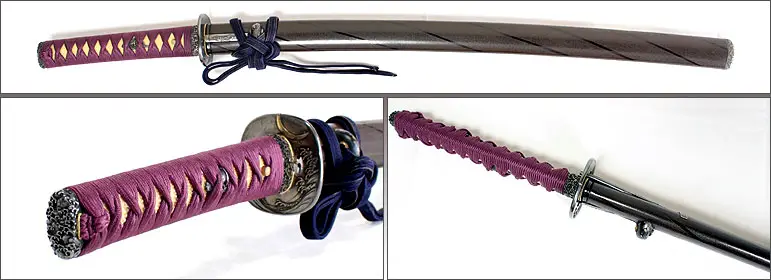 This sword was half a millenium old when Sergeant Pepper was released, and before cars had to have headrests and shoulder belts in the USA.
This sword was half a millenium old when Sergeant Pepper was released, and before cars had to have headrests and shoulder belts in the USA.
It is attributed to a master swordsmith named Kanesada, was engraved by a named master, and was made for a swordsman named Fukazaka, of which nothing is known except that his taste in swords was sublime. It can be yours for something over a million Japanese yen.
Japanese swords are unique in the world of edged weapons. Their engineering was, for the day (and for today, for that matter), remarkable. They mastered the impossible task of making the same blade strong, rigid, flexible, durable and razor-sharp. Normally metallurgy presents the engineer with a series of properties, but only lets him choose a few of them, for a metal that takes a razor edge, for example, seldom can hold it long; a sword that can slice through a man’s torso, powered by a strong warrior’s swing, seldom can take the blow of a thrust upon its tip. The Japanese innovation was in using laminated forged steel (much like Damascus steel) to give a blade multiple properties, and then using separate heat-treatment techniques for separate parts of the blade to produce, again, multiple properties.
There was nothing like it before, and there has been little like it since, although there has been a renaissance of blade-making (something watched with a beady eye and stringent licensure by the authorities). The finest Japanese swords arguably date from before the shogunate, and the very best of them are restricted from export, as they are considered part of the nation’s cultural patrimony. The bulk of the antique swords offered by dealers like Kanshoan are from later periods. For example, the Meiji Restoration era (1800s) is well represented. Twentieth century, Showa-era swords, particularly the many swords made for military use during Japan’s long midcentury war, are in a hot spot in Japan as they are not considered culturally desirable artifacts, but they are still swords and proscribed from most Japanese owners. (Showa-era swords that are products of individual artisans are on somewhat firmer ground as works of art).
Kanshoan divides their available swords by vintage: a sword is either “Historical” or a “New Age Sword,” by which they presumably don’t mean it’s intended to be used by a drum circle in Sedona. It means it’s produced by a living (or recently-living) swordsmith.
All historical swords (and the “new age” ones, too, frankly) are irreplaceable, unique works of art and science. But that doesn’t mean they’re staggeringly expensive. This is a detail of a Meiji era (1902) sword blade made by master Minamotono Masayuki.
If you have to ask, maybe you can afford it: while the ¥650,000 price seems daunting, it’s really $5,300 — if Japanese authorities will clear it to leave the country, which they probably will.
Kanshoan explains their name like this:
Our name recalls the legend of Kansho, a famous sword smith
from the Go country of ancient China.As he worked by the forge, his wife, Bakuya, cut her hair and
nails and threw them into the blazing furnace.
Just then, two swords of unparalleled beauty were created.
The “Kansho-Bakuya” swords were to become known throughout the
country and by all ages as the finest ever produced.We named KANSHOAN for this legend, as a place where you can
find historical and modern swords of such high quality and
legendary craft.
And they have this hope:
KANSHOAN hopes that its customers will act as golden
bridges between the past and the future, by passing on to
future generations the rich cultural heritage embodied in
Japanese swords.
Hear, hear.
Kanshoan is only one of several shops specializing in Japanese swords for the worldwide market. It makes a good visit if you have any fondness for beautiful weaponry.
We started this post many weeks ago, and set it aside when we ran into a complication. Tonight, we unearthed it again, after looking at a sword.
The sword eased our mind, and encouraged us. There may be something to that poem. A friendly Banzai to Kanshoan Sword Shop.
Pedro Augustin Guest Post: Inside the Arms Room of the Swiss Guard
The Swiss Guard are the elite guard force of Vatican City. Familiar to tourists for their colorful uniforms, they’re also a modern guard and defense force — and the last vestige of a lost Swiss tradition of providing mercenaries to foreign sovereigns.
A WeaponsMan.com reader who prefers to be pseudonymous, and who happens to have two qualifications the Swiss Guard respect — he’s a practicing Catholic, as they are, and a US Marine Embassy Guard, a protective duty much like theirs — was invited to visit their arms room. It may be the only working arms room in the world where weapons from several centuries are maintained in constant readiness, whether for a routine ceremonial guard mount or to respond to a terrorist attack.
Without further ado, here is the report from “Pedro Augustin” (pseud). –Ed.
I recently returned from a trip to the Eternal City with my wife’s family and was able to make a tour that I thought you might enjoy hearing about. Being a Marine with a similar duty, I had a special interest in seeing the barracks of my counterparts in the Vatican — so when my brother-in-law said he could get us and a tour of the armory of the world’s oldest continuously operating army — I jumped at the chance.
We met a Vice Corporal at the gate on a busy Roman street. Walking through, I watched eager tourists obviously interested in our entrance into the gate. Vatican City’s Porta Sant’Anna is not a public gate, after all. We were ushered past the crowds, guard at the front desk office, surrounded by unknown flags and colorful uniforms.
We entered a courtyard, where water flowed into an ancient Roman sarcophagus which pre-dated Constantine. While my home state of Virginia possesses some of America’s first artifacts, the age of this courtyard’s residents and history was visible in every way.
The Guardia Svizzera Pontificia, or Pontifical Swiss Guard, has operated continuously for over 509 years. This reinforced company sized unit is composed of 110 men. They are led by a commandant and three officers, 1 SNCO and 25 NCO’s. The courtyard was draped with large flags representing the different states in Switzerland. Blonde children were running around the courtyard, in a quiet respite from Rome’s busy streets, just on the other side of the walls.
The army of Vatican City is perhaps best known for their ceremonial duties, but they also perform body-guard duties comparable to our U.S. Secret Service (they perform a blend of both uniform and special agent division duties). Personal security of the pope is split between the Vatican Police and Swiss Guard.
We crossed the courtyard into a building and were led down a short staircase. Inside the barracks, the Swiss Guards have their own tailor shop to fabricate the soldiers’ entire repertoire of uniforms. Their famous “Gala Uniforms” take 40 hours per solider to create. I saw two different uniforms in service that day, which we learned both have summer and winter-weight versions. They also wear suits, depending on the post. I thought Marines had a lot of uniforms until seeing their uniform list, both ceremonial and utility. No fatigues or camouflage, but quite a number of service and dress variations. They also have their own music corps of talented musicians.
I was surprised that we were led into the armory, and without all the usual tell-tale signs of a leatherneck’s iteration. It was clear that this was not the storehouse of (all) their modern weapons, but it was a functioning armory nonetheless. Given the unit’s age, it is no small collection.
The armory had halberds, swords, bayonets the length of swords, two-handed swords, a blunderbuss that must have weighted 40 lbs, and bolt-, semi-, and automatic weapons used throughout their history. There were also the traditional medieval sets of armor that they are famous for, weighing close to 40lb each. These armor suits are still worn daily. It amazed me how far we have come in both personal protection and weapon technologies, and that one organization experienced these many developments first hand. Remarkable.
I was only able to identify two weapons from sight- the pair of Sig 550’s and an MP40. (We can plug those gaps for him — Ed.) The latter was surrendered at the end of WWII by a Nazi soldier whose unit besieged the Vatican during the war. Shortly before Rome was abandoned by the Germans, he turned himself over to the Swiss Guards. The unnamed soldier’s weapon and helmet are still kept there in pristine condition alongside the Swiss weapons. If the weapons in that room could talk, I can only imagine the tales they would tell.
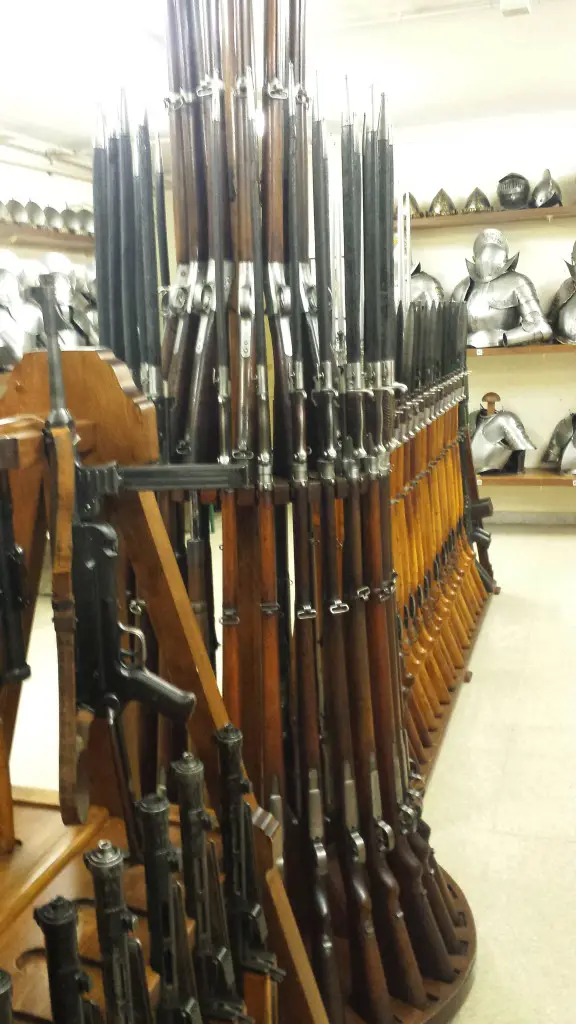
In the foreground, you can see the MP.40 mentioned above. You can also see Hispano-Suiza Mp. 34 licensed copies of Finnish Suomi submachine guns (low left), Martini-Henry Remington-patent Pontifical Rolling Block rifles (top center), what look like Mauser 98s (below the Martinis), and on the right, in the light-colored birch stocks, the special run of 100 Schmidt-Rubin K31 Short Rifles made expressly for the Swiss Guard.
There were SMGs, carbines, rifles, though there was a conspicuous lack of pistols from any time period. One carbine was short and looked slightly odd, though I didn’t quite know why at first. I later learned it was a SIG MKPO, with a unique folding magazine. Another reminded me of a Marlin .22 from my younger days, but was elaborately engraved. Some of side-mounted bayonets were shorter (not terribly, though) than the Marine NCO sword. Axes, clubs, and various poled-weapons also filled some space.
The armory was a beauty that readers of Weaponsman would appreciate- the orderly presentation of such beautifully preserved weapons from bygone eras. I was also struck at how well everything was kept- there wasn’t a spot of rust to be seen anywhere. Edged weapons, armor, firearms were all in pristine condition, including the beautiful engravings on the many wood-stocked firearms. It certainly was a different place than a Marine armory.
Requirements to join the Swiss Guards are strict: one must be of Swiss nationality, Catholic, of good character, and already a member of the Swiss army. The Vice Corporal noted that Pope Francis has used the Swiss Guards more than his predecessors, and their increased operational tempo reflects this. While they are recruiting to add to their ranks, my brother-in-law (at 10 years old, Catholic, not Swiss and not a member of any army) was denied an application.
New members take their oath on 6 May, to commemorate the fighting when Rome was sacked in 1527. With the city under siege and attack, the Swiss Guards fought a delaying action to grant the pope time to travel via tunnel from Vatican City to Castel Sant’Angelo, about one kilometer. Of 189 Swiss Guards, only 42 survived. They succeeded in getting Pope Clement VII to safety, and commemorate this each year with the swearing-in ceremony. There were some peculiarities of the unit- they are not allowed to marry until they reach a certain time in service, possess the proper rank, and an apartment is available inside Vatican City, where residence there is a requirement. The entire Guard must be fluent in Italian and Swiss German (distinctly different from German, which I did not know), and English lessons are highly encouraged. Others spoke French and/or Spanish. The Vice Corporal who led us was conversant in half a dozen languages. I’m sure Hognose had a different experience than I did, but I couldn’t imagine a Marine unit with that much linguistic skill and depth.
(To answer the implied question here — SF units have linguistic skills, but they tend to be regionally focused, unlike the Swiss Pontifical Guard which has a global mission. Any grunt company in the Army — and probably the Marines as well — can give you speakers of English, Spanish, and a couple other languages. But it’s pot luck what languages you get in the conventional forces, because it’s just a result of immigrants or first-generation American-born kids of immigrants enlisting. SF’s language training is more systematic, but then, theirs is more of a face-to-face than shoot-em-in-the-face mission. -Ed).
After the armory, we went back to the courtyard for the conclusion and return trip to the hotel. It was quite interesting to see how different and similar their military is to my experience in the Marines. Some things never change for soldiers, no matter the time or place. The visit certainly gave me much to reflect on, for my time in Marines, the Swiss Guards, and other militaries before us.
For More Information
The Swiss Guard official page: http://www.vatican.va/roman_curia/swiss_guard/swissguard/divisa_en.htm
Another (official or not? We don’t know) Vatican page:
http://www.guardiasvizzera.va/content/guardiasvizzera/en/storia/mercenari-svizzeri.html
A Guns.com story on the Swiss Guard armory:
http://www.guns.com/2014/04/13/guns-swiss-guard/
Update
This post has been corrected. An erroneous reference to Martini-Henry rifles in the second to last photo caption has been altered to show that they are special rifles made on the Remington Rolling Block patent for the Pontifical Guard in the late 1800s. Thanks to the several commenters who pointed this out (and provided links to some great photographs of these rifles.
You Never Know What You’ll Find when You Turn Over the Rocks
In the case of Goran Olsen, a Norwegian hiking in Haukeli, on the border of Telemark and Hordaland, an outdoorsman’s paradise in a country that has plenty of them, what was under the rocks was this sword.
CNN reports that he:
…stumbled across a 1,200-year-old Viking sword while walking an ancient route.
The find, which dates from approximately 750 A.D. and is in exceptionally good condition, was announced by Hordaland County Council.
County Conservator Per Morten Ekerhovd described the discovery as “quite extraordinary.”
“It’s quite unusual to find remnants from the Viking age that are so well-preserved … it might be used today if you sharpened the edge,” he told CNN.
Outdoorsman Goran Olsen made the unusual find when he stopped for a rest in Haukeli, an area known for fishing and hunting about 150 miles (250 kms) west of capital, Oslo.
The rusted weapon was lying under some rocks on a well-known path across a high mountain plateau, which runs between western and eastern Norway.
via Hiker finds 1,200-year-old Viking sword under rocks – CNN.com.
This story seems almost too good to be true. How many hikers, hunters, and outdoors lovers must have trod that Viking path? The Viking roads, which traveled the mountains the hard way, from crest to crest, are well known to (and widely enjoyed by) today’s Norwegians. Mr Ekerhovd thought that the sword was so well-preserved because the area alternates with being snow-covered for six months and rather dry for the rest of the year. He could only speculate on the sword’s provenance. Did it belong to a fallen traveler, taken by accident, disease or weather? Or was it somehow uprooted from a Viking burial site (they didn’t all go out to sea in flaming ships, or the museums of Norway would be missing many of their most fascinating artifacts)? It’s unlikely anyone will ever know.
Which is almost as unlikely as finding the sword in the first place.
The sword, which was found without a handle, is just over 30 inches long (77 centimeters) and made of wrought iron. From its type, archaeologists estimate it to be from around 750 A.D. — making it approximately 1,265 years old — but warn that this is not an exact date.
Swords like this were status symbols in Viking times because of the high cost of extracting iron, Ekerhovd said, and it’s likely this blade would have belonged to a wealthy individual.
Haukeli is nearly at (just west of) the geographic center of a triangle with vertices at Bergen, Oslo, and Stavanger. In the Medieval Warm Period the Viking chiefs saw their greatest power both at home and abroad.
The sword is not what you usually think of when the term “Viking sword” is bandied about. It has a straight back and a curved point. This implies a single edge, unlike the classic double-edged Viking weapon. Indeed, Norwegian archaeologists seem to think it was a Western weapon, perhaps acquired by capture or trade, and, either way, a marker of a significant chieftain.
The best Viking swords were made of crucible steel, something that the great seafarers may have gotten from Central Asia, as it wasn’t invented in Europe until the 18th Century, and required technology capable of heating metal to 3,000ºF (about 1,700C). This is a more typical Iron Age weapon.
Next spring, there may be an archaeological expedition to the site to seek any other artifacts, or even a gravesite that is speculated to have been the source of the sword. In the meantime, the authorities have a good relationship with the metal-detector hobbyists in the area, so they expect to be notified of any finds the detectors turn up over the winter. In the meantime, the new sword will probably go to the Bergen Museum to be conserved properly, and be further studied by experts!
Thanks to the user that tipped us off about this find! And here’s a thought: how many more Viking Age swords, spears and other weapons are still out there to be found?
For More Information:
- Daily Mail story
- Norwegian-language Hordaland Council story (with more photographs and photos and story of another find, a bronze buckle from a woman’s dress, circa AD 800-850).
The Spetsnaz Ballistic Knife
Here’s an item from the Cobwebbed Arms Locker here at Hog Manor. Acquired during the weapon’s brief flowering of legality in the USA in 1984, it was sold as a “Spetsnaz ballistic knife.” Recent research has convinced us what we believed at the time was true, that this knife was a US-made knife intending to capitalize on the “ballistic knife” craze. In this post, we’ll tell you what we’ve learned about these knives, and our still-unsatisfied search to see if Soviet Spetsnaz ever did issue such a toad-stabber.
And yes, we’ll tell you how it works.
The “ballistic knife” hit the weapons world like a cannon shot in 1983 or 1984. In 1978, a series of books by a Soviet defector to Great Britain appeared in the West. The officer, Viktor Belyayev, was a GRU man who had served in the Soviet Army, then in Spetsnaz reconnaissance, then finally as a GRU officer under official cover in Switzerland. He used the pen name “Viktor Suvorov,” the name of a great Tsarist era general and legend of Russian arms whose name honors a series of Russian military academies (including the one the defector graduated from). We get the impression that modesty is not among his traits. In any event, people in the West (especially the US and UK) were always curious about the Soviet Union and its secret organs, and “Suvorov’s” books were very successful. They were well written and, we know now, told both deep truths and fanciful tall tales about the Soviet services.
We were absolutely sure that the first story of the Spetsnaz “ballistic knife” came from Suvorov’s Spetsnaz, but recently reread the book in e-format and even searched for instances of knife with no joy. So where did it come from? We still like him as the source, but wonder if it was a Soldier of Fortune article or something that spawned the Ballistic Knife craze.
And craze it was. In a matter of a couple years, the usual foes of liberty in Washington, led by Five Families associate and later-disgraced corrupt senator Alphonse D’Amato (R-NY), had drummed up enough hysteria to push through a bizarrely written Federal ban. Their handmaidens in many state legislatures followed suit, and there is a spotty and uneven ban in effect that has stopped the interstate manufacture and sales of these knives, although “parts kits” are intermittently available. In some states, manufacture for personal use is also banned, and you have to be leery of “constructive possession” statutes and case law. The Federal statute has some exceptions, including for military personnel.
Why any military person would want such a knife is another question. We wanted it because it was a “Spetsnaz knife,” a story which seems to have proven a total fabrication.
(Due to the length of this post — over 2600 words — it continues after the jump, with The History, The Ballistic Knife in Use, Auction Action, and Misinformation and Information subheadings).

Kevin was a former Special Forces weapons man (MOS 18B, before the 18 series, 11B with Skill Qualification Indicator of S). His focus was on weapons: their history, effects and employment. He started WeaponsMan.com in 2011 and operated it until he passed away in 2017. His work is being preserved here at the request of his family.

